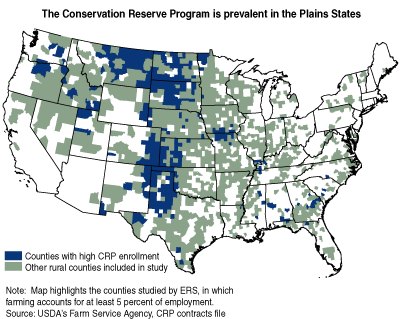How Does Farmland Retirement Affect Rural Counties?
- by Daniel Hellerstein and Patrick Sullivan
- 6/1/2004
The Conservation Reserve Program (CRP) offers incentives for producers and landowners to voluntarily retire highly erodible and other environmentally sensitive cropland from production for 10-15 years. Retired land is planted to grasses, trees, and other cover, thereby reducing erosion and water pollution and nurturing wildlife. In exchange, producers receive annual rental payments and cost-share assistance. Approximately 34 million acres are currently enrolled in the CRP.
The program’s benefits to the environment, CRP participants, and other crop farmers (through less output and higher prices) have made it a recurring focus of farm program legislation. However, the CRP’s effect on farm communities has been a concern. Enrollment in CRP could weaken demand for farm inputs and agricultural marketing services, and many rural economies depend on such ancillary services, especially in the Plains where the CRP is prevalent (see “One in Five Rural Counties Depends on Farming”).
While anecdotal evidence suggests that the CRP has negatively affected some rural communities, recent ERS research indicates that, in the aggregate, impacts have been limited. High CRP enrollment did not have a statistically significant adverse effect on population trends in farm counties across the U.S. And while CRP enrollment was associated with some job loss in rural counties between 1986 and 1992 (the years immediately following the program’s introduction), this negative relationship did not persist throughout the 1990s. Further, ERS research uncovered no statistically significant evidence that CRP participation encourages absentee ownership or that high levels of CRP participation affected local government services or tax burdens in a systematic way.
CRP participants can enroll either all (whole-farm) or part (partial-farm) of their eligible acreage, which has raised questions about how this choice affects the neighboring community. For both whole- and partial-farm participation, CRP was associated with slower job growth in the short term, but had no longer-term effect on the community. Whole- and partial-farm enrollment had different effects on the number of beginning farmers, who typically rent the land they farm. Whole-farm enrollments had negative impacts on the number of beginning farmers, while partial-farm enrollments had a positive impact.
This article is drawn from:
- Conservation Programs. (n.d.). U.S. Department of Agriculture, Economic Research Service.


